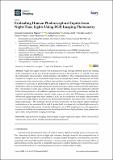Por favor, use este identificador para citar o enlazar a este item:
http://hdl.handle.net/10261/190046COMPARTIR / EXPORTAR:
 SHARE SHARE
 CORE
BASE CORE
BASE
|
|
| Visualizar otros formatos: MARC | Dublin Core | RDF | ORE | MODS | METS | DIDL | DATACITE | |

| Título: | Evaluating human photoreceptoral inputs from night-time lights using RGB imaging photometry |
Autor: | Sánchez de Miguel, A.; Bará, S.; Aubé, M.; Cardiel, N.; Tapia, C.E.; Zamorano, J.; Gaston, Kevin J. | Palabras clave: | Artificial night lights Circadian phototransduction DSLR cameras Imaging Light pollution Night-time lights Non-visual effects of light RGB sensors |
Fecha de publicación: | 2019 | Editor: | Multidisciplinary Digital Publishing Institute | Citación: | Journal of Imaging 5(4): A49 (2019) | Resumen: | Night-time lights interact with human physiology through different pathways starting at the retinal layers of the eye; from the signals provided by the rods; the S-, L- and M-cones; and the intrinsically photosensitive retinal ganglion cells (ipRGC). These individual photic channels combine in complex ways to modulate important physiological processes, among them the daily entrainment of the neural master oscillator that regulates circadian rhythms. Evaluating the relative excitation of each type of photoreceptor generally requires full knowledge of the spectral power distribution of the incoming light, information that is not easily available in many practical applications. One such instance is wide area sensing of public outdoor lighting; present-day radiometers onboard Earth-orbiting platforms with sufficient nighttime sensitivity are generally panchromatic and lack the required spectral discrimination capacity. In this paper, we show that RGB imagery acquired with off-the-shelf digital single-lens reflex cameras (DSLR) can be a useful tool to evaluate, with reasonable accuracy and high angular resolution, the photoreceptoral inputs associated with a wide range of lamp technologies. The method is based on linear regressions of these inputs against optimum combinations of the associated R, G, and B signals, built for a large set of artificial light sources by means of synthetic photometry. Given the widespread use of RGB imaging devices, this approach is expected to facilitate the monitoring of the physiological effects of light pollution, from ground and space alike, using standard imaging technology. © 2019 by the authors. | Versión del editor: | http://dx.doi.org/10.3390/jimaging5040049 | URI: | http://hdl.handle.net/10261/190046 | DOI: | 10.3390/jimaging5040049 | ISSN: | 2313433X |
| Aparece en las colecciones: | (IAA) Artículos |
Ficheros en este ítem:
| Fichero | Descripción | Tamaño | Formato | |
|---|---|---|---|---|
| IAA_2019_jimaging-05-00049-v2.pdf | 2,12 MB | Adobe PDF |  Visualizar/Abrir |
CORE Recommender
SCOPUSTM
Citations
9
checked on 22-abr-2024
WEB OF SCIENCETM
Citations
9
checked on 17-feb-2024
Page view(s)
158
checked on 23-abr-2024
Download(s)
159
checked on 23-abr-2024
Google ScholarTM
Check
Altmetric
Altmetric
NOTA: Los ítems de Digital.CSIC están protegidos por copyright, con todos los derechos reservados, a menos que se indique lo contrario.
